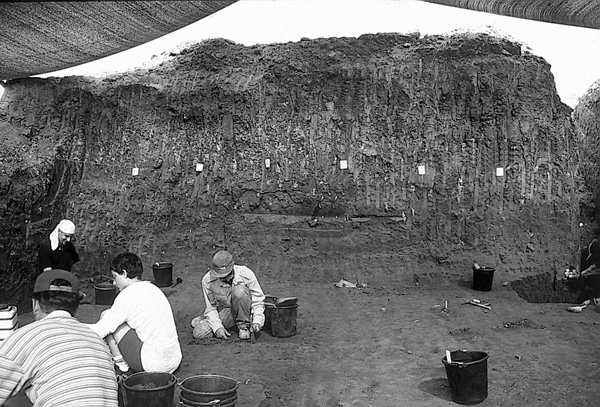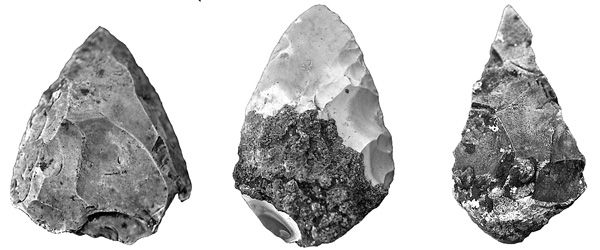Eyal 23
INTRODUCTION
The Lower Paleolithic site Eyal 23 is located in the eastern Sharon Coastal Plain. The plain is composed mainly of beds of quartz sand separated by red loams (
The site was excavated in 1996–97 as a salvage project, part of the construction of the Trans-Israel Highway, directed by A. Ronen of the University of Haifa. It is on a hill 67 m above mean sea level near Kibbutz Eyal. The eastern slope of the hill was excavated, revealing a thick series of red loams overlying a sand layer.
STRATIGRAPHY
The following stratigraphy was observed:
Unit 1a: A brown-gray grumusol c. 0.5 m thick.
Unit 1b: Dark brown-gray grumusol c. 1.5 m thick, with a higher clay content than unit 1a.
Unit 2: A transition zone, 0.5 m thick, between the grumusol and the red loam of unit 3.
Unit 3: The upper red loam, very hard, c. 0.6 m thick.
Unit 4: The lower red loam, c. 1 m thick, less hard than unit 3.
Unit 5: A glei, c. 1 m visible thickness till the base of excavation.
The underlying unconsolidated sand (archaeologically sterile, as always on the Coastal Plain) is exposed in a quarry a few hundred meters to the west.
The following interpretation may be offered of the sequence described above: Unit 1 was accumulated under marsh conditions and the sediment is an alluvial deposit originating in the east. Units 2 through 5 were developed from aeolian sands transported from the seashore in the west. The glei of unit 5 indicates the position of ground water. Attempts to date the Eyal sediments by thermoluminescence (TL) and infrared stimulated luminescence (IRSL) methods were unsuccessful.

THE FINDS
The finds are in mint condition and most were recovered in a horizontal position, indicating minimal post-depositional displacement, if any at all. Complete items number 60–68 percent in the layers. Five archaeological occupations (layers 1–5) were identified. There are hand axes in all the layers except for the lowermost, layer 5. Eyal 23 has the longest Acheulean sequence known on the Coastal Plain. The following is a correlation of its geological units with archaeological layers:
Unit 1: Layer 1.
Unit 2: Layer 2.
Unit 3: Layer 3.
Unit 4: Layers 4 and 5.
Unit 5: Sterile.
Layer 1 is found in the upper unit, the grumusol, and was probably affected by agricultural activities. Layer 2 is in geological unit 2, the transition zone between the red loam and the dark brown grumusol. Layer 3 is located in unit 3, the upper red loam. Both layers 4 and 5 are in the lower red loam of geological unit 4. Retouched items in all the layers are few. Unfortunately, bone is not preserved at Eyal.

Layer 1 is similar to layer 2. Both are relatively rich in Levallois products and faceted butts. There are racloirs, points, denticulates, and a few other tool types, including small hand axes of fine manufacture, typical of the upper Acheulean of the Coastal Plain. Layer 3 yielded a trihedral, an unusual tool type for the upper Acheulean. Although the Eyal trihedral was more elaborately manufactured than the lower Paleolithic ones from ‘Ubeidiya, judging by this specimen, layer 3 of Eyal may belong to the middle Acheulean. The majority of tools in layer 3 are notches and denticulates. There are relatively fewer Levallois items here and fewer faceted butts than in the overlying layers. Layers 4 and 5 have the largest proportion of unprepared butts among the Eyal series.
The long sequence of Acheulean occupations at Eyal—the longest hitherto discovered on the Coastal Plain of Israel—seems to represent one and the same tradition. Levallois technique is present in all the occupations, but it is more developed and numerous in the upper horizons. Butt preparation at the site develops over time from almost entirely unprepared in the lowest horizon to a fair amount of faceting in the upper horizons. Over time, items become larger on average. The small number of tools in the Eyal assemblages does not allow for an assessment of a typological trend over time.
AVRAHAM RONEN
INTRODUCTION
The Lower Paleolithic site Eyal 23 is located in the eastern Sharon Coastal Plain. The plain is composed mainly of beds of quartz sand separated by red loams (
The site was excavated in 1996–97 as a salvage project, part of the construction of the Trans-Israel Highway, directed by A. Ronen of the University of Haifa. It is on a hill 67 m above mean sea level near Kibbutz Eyal. The eastern slope of the hill was excavated, revealing a thick series of red loams overlying a sand layer.
